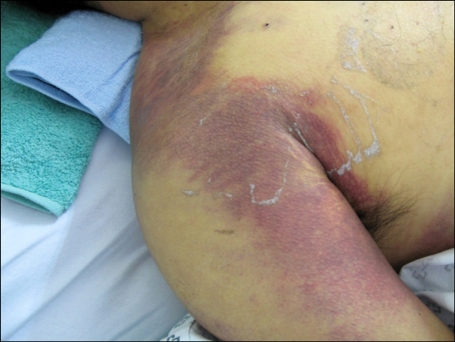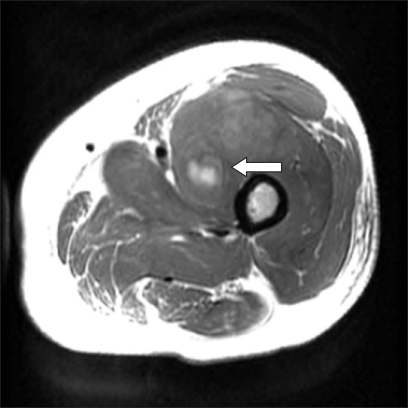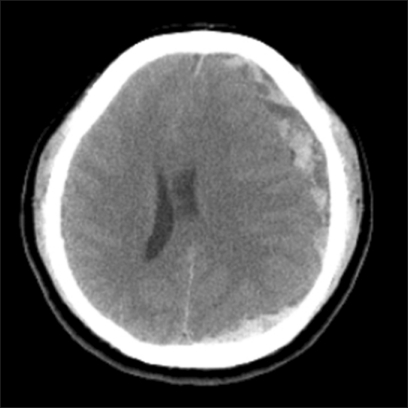Korean J Hematol.
2010 Sep;45(3):205-207. 10.5045/kjh.2010.45.3.205.
Acquired factor VIII deficiency after consuming the dried gallbladder of a cobra, Naja naja
- Affiliations
-
- 1Department of Hemato-Oncology, Busan Paik Hospital Inje University, Busan, Korea.
- 2Department of Microbiology, Center for Viral Disease Research College of Medicine, Inje University, Busan, Korea.
- 3Department of Hemato-Oncology, Haeundae Paik Hospital Inje University, Busan, Korea. yjoo@inje.ac.kr
- KMID: 2252065
- DOI: http://doi.org/10.5045/kjh.2010.45.3.205
Abstract
- Acquired factor VIII deficiency is very rare, often fatal. It is associated with pregnancy, autoimmune diseases, malignancy, and drugs, although no underlying cause is found in 50%. A 49-year-old male was referred with right shoulder bruising. The coagulation test showed a prolonged activated partial thromboplastin time. The factor VIII level was less than 1%, and the factor VIII inhibitor antibody titer was 246 Bethesda units/mL. The findings were compatible with acquired factor VIII deficiency. He had consumed the dried gallbladder of a cobra, Naja naja, for two weeks, it contained venom. After the initial treatment with factor VIII, he did not take supplemental coagulation factor VIII. The patient was readmitted with left forearm swelling. He lost consciousness suddenly and brain computed tomography (CT) revealed a subdural hematoma. Despite administering recombinant factor VII, his bleeding was not controlled and he died.
MeSH Terms
Figure
Reference
-
1. Hay CR. Acquired haemophilia. Baillieres Clin Haematol. 1998; 11:287–303. PMID: 10097808.2. Hay CR, Baglin TP, Collins PW, Hill FG, Keeling DM. The diagnosis and management of factor and IX inhibitors: a guideline from the UK haemophilia centre doctors organization (UKHCDO). Br J Haematol. 2000; 111:78–90. PMID: 11091185.3. Franchini M. Postpartum acquired factor VIII inhibitors. Am J Hematol. 2006; 81:768–773. PMID: 16868941.
Article4. Stewart AJ, Manson LM, Dasani H, et al. Acquired haemophilia in recipients of depot thioxanthenes. Haemophilia. 2000; 6:709–712. PMID: 11122403.
Article5. Sallah S, Wan JY. Inhibitors against factor VIII associated with the use of interferon alpha and fludarabine. Thromb Haemost. 2001; 86:1119–1121. PMID: 11686336.6. Regina S, Colombat P, Fimbel B, Guerois C, Gruel Y. Acquired inhibitor to factor VIII in a patient with Hodgkin's disease following treatment with interferon-alpha. Haemophilia. 2001; 7:526–527. PMID: 11554946.
Article7. Moraca RJ, Ragni MV. Acquired anti-FVIII inhibitors in children. Haemophilia. 2002; 8:28–32. PMID: 11886462.
Article8. Lottenberg R, Kentro TB, Kitchens CS. Acquired hemophilia. A natural history study of 16 patients with factor VIII inhibitors receiving little or no therapy. Arch Intern Med. 1987; 147:1077–1081. PMID: 3109341.
Article9. Tagariello G, Sartori R, Radossi P, Gandini G, Franchini M. Intensive blood transfusion support in acquired hemophilia A. Ann Hematol. 2007; 86:229–230. PMID: 17151880.
Article10. Delgado J, Jimenez-Yuste V, Hernandez-Navarro F, Villar A. Acquired haemophilia: review and meta-analysis focused on therapy and prognostic factors. Br J Haematol. 2003; 121:21–35. PMID: 12670328.
Article11. Franchini M, Gandini G, Di Paolantonio T, Mariani G. Acquired hemophilia: a concise review. Am J Hematol. 2005; 80:55–63. PMID: 16138334.12. Park EK, Jang JS, Park SY, Lee SJ. Two patients with acquired hemophilia successfully treated with combination therapy including therapeutic plasmapheresis. Korean J Med. 2009; 77:367–370.
- Full Text Links
- Actions
-
Cited
- CITED
-
- Close
- Share
- Similar articles
-
- Acquired factor VIII deficiency after consuming the dried gallbladder of a cobra, Naja naja
- A Case of Combined Congenital Deficiency of Factor V and Factor VIII
- Cranial Hemophilic Pseudotumor: Case Report
- Up-regulation of Bax and endonuclease G, and down-modulation of Bcl-X(L) involved in cardiotoxin III-induced apoptosis in K562 cells
- Acquired Hemophilia A with Gastrointestinal Bleeding




